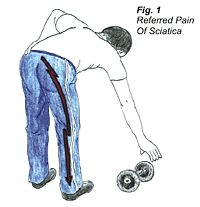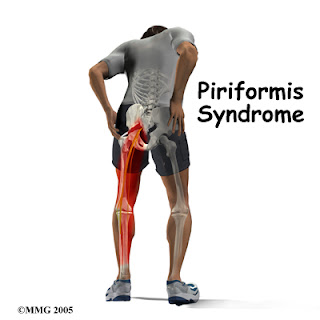Definition
Between 70% and 80% of the population of the world experience low back pain at some time during their lives. A subgroup of patients who experience back pain also experience sciatic pain as well. [1] Sciatica is defined as a burning, aching, or sharp pain in the distribution of a lumbar nerve root that sometimes radiates to below the knee that can result in neurosensory and/or motor (1%) disfunctions. The pain is typically perceived as radiating from the low back to the posterior buttocks, posterior thigh, and occasionally below the knee into the posterior calf and foot. [2]
As each nerve root has a sensory (sensory signals to the brain) and motor (activating the muscles) components to it, supplying in this case, the lower extremities, it is to be expected that an excess pressure on the lumbar nerve roots causes discomfort and/or pain in the buttocks and legs. [2]
Causes
Sciatica can occur from normal wear and tear, when the nerve is pinched between vertebrae or disk (cushion between vertebrae), a narrowing in the passageways by arthritis or swelling of a sprained ligament in the area. It becomes irritated and tender. At times, no exact cause is found, but a movement that is normally harmless (such as bending over) suddenly brings on violent pain. [3]
In about 90% of cases, sciatica is caused by a herniated disc with nerve root compression, but lumbar stenoses and (less often) tumours are possible causes. Also, a personal and occupational risk factors for sciatic have been reported. As for personal risk factors we have age, height, mental stress, cigarette smoking, and exposure to vibration from vehicles. Strenuous physical activity, such as frequent lifting, especially while bending and twisting, and driving, with vibration of whole body, are some of the occupational risks for sciatica. [4]
A disc herniation is a “leaking” of a portion of a jelly-like (nucleus pulposis) material between two vertebrae. The disc herniation most frequently occurs in the third to fifth age. Repetitive flexion, such as bending, especially when combined with rotation (e.g. swinging an ax), or a high force trauma (e.g. car accident), will cause tears in the disc. These tears will allow the leakage of the nucleus pulposis, which will cause compression on a lumbar nerve root. [2]
The most common cause of sciatica in people over the age of fifty is degenerative changes in the lumbar spine. This can lead to narrowing of the spinal canals and the intervertebral foraminal space (space between two adjacent vertebras) where the lumbar nerve roots exits the spine. [2]
Other causes that can provoke sciatica symptoms are muscle strain or athletic injuries. Repetitive strain of the piriformis and gluteus maximus musculature can cause pain in the buttocks and hamstring region. This pain usually radiates only to the knee, unlike true sciatica which can reach the calf. Driving for long periods with the foot on the accelerator and/or sitting with a heavy wallet in the back pocket can irritate the gluteus maximus and piriformis muscles. Concerning athletic injuries, running can cause stress on the gluteus maximus and piriformis musculature.
With each heel strike, there is normal internal rotation of the femur, whose motion is controlled by the piriformis. Overtraining may cause injury to the piriformis. Running uphill will cause forward flexion of the pelvis, which in turn may cause a strain of the gluteus maximus. [2]
Biking with the pelvis flexed too far forward while reaching for the handlebars can also strain the gluteus maximus musculature. If the handlebars are set too far below the seat level, the rider may be forced to lean too far forward. [2]
Symptoms
The most important symptoms are radiating leg pain and related disabilities. [4]
Patients will complain of numbness, tingling, or pins and needles anywhere along the path of the sciatic nerves. [3] Patients with sciatica may also have low back pain but this is usually less severe than the leg pain. [4]
[4]=[1] Douglas, S (1997). Sciatic pain and piriformis syndrome. The Nurse Practicioner; 22
[1]=[2] Dubin, J.C. (2002). Injury Management Update
[2]=[3] Jurist, K., A. et Guettler, J., H. Sciatic
[3]=[4] Koes, B., W., van Tulder, M., W. et Peul, W. C. (2007). Diagnosis and treatment of sciatica. BMJ; 334: 1313-1317




Sem comentários:
Enviar um comentário